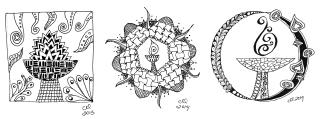Advertisement
“What is your spiritual practice?” is a question I heard often during seminary, and I continue to encounter it as a minister. For a long time, I had no strong answer. As a humanist, prayer wasn’t something I ever found helpful, although I tried it. I found I could sit still in meditation and empty my thoughts just fine, but felt no positive effect from having done it. I journaled, and dabbled in writing and reading poetry, but was at best irregular in maintaining these disciplines. I spend so much of my time with words that a spiritual practice involving more words, while natural, also seemed redundant. I liked making crafts and singing, but I didn’t have a regular practice of any of it nor consider what I did spiritual.
Then one day at a friend’s house, I noticed a small box with the word “Zentangle” on it and asked her what it was. She showed me the book One Zentangle a Day by Beckah Krahula, which teaches a spiritual practice based in meditative doodling. I was instantly interested. I purchased the book for myself and started working my way through it.
To create a Zentangle you begin with a penciled frame and then draw a “string” through the frame to divide the box into sections. In each section you draw a repetitive pattern, called a “tangle.” The meditation comes both in the rhythmic drawing and in reflecting on your work afterward, thus the word “Zen” within “Zentangle,” used loosely to indicate a meditative practice. The book starts you off with a few patterns, adding about three new patterns per day.
On the third day, I drew my string to divide the square into a chalice shape. Within a couple of weeks, I started doing a chalice every day that I Zentangled, and pretty soon I was Zentangling chalices almost exclusively.
You can Zentangle in a very meditative state, or you can do it more distractedly while also doing something else, from watching TV to sitting in a meeting. I find that Zentangling chalices, even when I do it in a more distracted mode, is a valuable spiritual practice for me. The chalices connect me back to Unitarian Universalism with every doodle.
My sister, Carrie Landrum, showed me some mandalas she had created and told me about how she was exploring drawing mandalas as a spiritual practice. I had seen Buddhist sand mandalas before, and had even participated in creating one at Starr King School for the Ministry, but I hadn’t further explored the idea of mandalas. Mandalas can be strictly prescribed in form, particularly in some Buddhist practice, but the term can be used more loosely to mean a geometric pattern created in representation of the cosmos. I didn’t pick up on this idea right away, but noticed there were some Zentangle mandala books and products, so I added them to my Christmas wish list and kept doing chalices, since I felt that practice was working for me and there was plenty of room to explore within that form.
I was still Zentangling chalices when I attended my ministerial study group, Ohio River Group, last fall. Our subject was “Art and Religion,” and the Rev. Susan Smith from the Southern Region staff led the worship services. She introduced us to the book Praying in Color: Drawing a New Path to God by Sybil MacBeth. In MacBeth’s practice, you write down the name of someone you want to include in your prayers, and you start doodling around it while thinking of the person. I found that the doodling easily could be Zentangling and combined the two ideas, doing some Zentangle/Praying in Color prayers during my time at the conference.
I’ve incorporated some of MacBeth’s thoughts into my spiritual practice. I still don’t usually work in color, but if I come to feel I’ve reached the limitations of black and white, perhaps then I’ll branch out. What I do now is think of a specific person or issue at the flame as I doodle the chalice, and write down the name or topic I was thinking about at the bottom of the page.
I made one Zentangle while watching the science fiction series Doctor Who. The chalice is holding back the evil Zygons. It was something of a metaphor for how our faith equips us to deal with trouble in the world, but a silly one. At other times, however, the exercise is much more meaningful. I made another on the anniversary of the Sandy Hook shootings, thinking about those families and the family of a former member of my congregation and her son, who had been murdered a week before in an act of domestic violence. The practice of Zentangling helped me through the sorrow and stress of those events.
For Christmas last year I received the book Zen Mandalas by Suzanne McNeill, and I started incorporating mandalas into my Zentangle chalices. I find putting the chalice at the center of the mandala makes the mandala form and the Praying in Color form work well together.
Spiritual practice is still not an everyday thing for me, but during the last year I’ve made one hundred Zentangle chalices. I find it remarkable that restricting the format—always a chalice, and always in a box or in a mandala—doesn’t make me feel that my creativity is restricted. I’m always free to draw something else if I choose, and occasionally I do. Rather, the restricted form is a way of pulling in my thoughts, freeing me from getting distracted by what I want to do with the design, as I focus instead on the repetitive strokes that make up the individual patterns.
Unitarian Universalism may have only one major symbol, but it’s a symbol that has opened me up to a world of possibilities in spiritual practice.
This article appeared in the Fall 2014 issue of UU World (page 18). Illustrations (above): © Cynthia L. Landrum.
